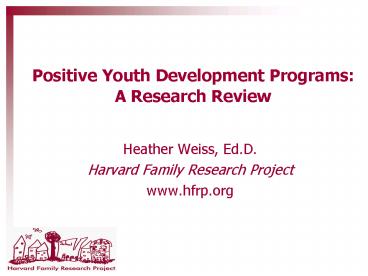Positive Youth Development Programs: A Research Review PowerPoint PPT Presentation
1 / 17
Title: Positive Youth Development Programs: A Research Review
1
Positive Youth Development Programs A Research
Review
- Heather Weiss, Ed.D.
- Harvard Family Research Project
- www.hfrp.org
2
HFRPs Out-of-School Time (OST) Evaluation
Database
- Contains profiles of program evaluations from
across the country - Criteria for inclusion
- Program operates during out-of-school time
- Evaluation aims to answer specific question(s)
- Serves children ages 5-19
- Available at www.hfrp.org
3
Participation is Important for Academic Success
- Better attitudes toward school and higher
educational aspirations - Better performance in school, as measured by
achievement test scores and grades - Higher school attendance (as measured by
attendance and tardiness) - Less disciplinary action (e.g., suspension)
4
Participation is Important for Social/Emotional
Development
- Decreased behavioral problems
- Improved social and communication skills and/or
relationships with others (peers, parents, and/or
teachers) - Increased community involvement and broadened
world view - Increased self-confidence and self-esteem
5
Participation is Important for Healthy Physical
Development
- Avoidance of drug and alcohol use
- Decreases in delinquency and violent behaviors
- Increased knowledge of safe sex and avoidance of
sexual activity and pregnancy - Increased skills for coping with peer pressure
6
Participation is Important for 21st Century Skill
Development
- Expert Thinking Identifying and solving new
problems - Complex communication Eliciting critical
information and conveying a convincing
interpretation of it to others - Proficiency in the basics
7
Spotlight on Positive Youth Development Programs
- Many programs include positive youth development
activities and goals with academic enrichment.
Evaluations reveal positive associations with
academic outcomes. - Even some PYD programs that do not include an
academic component demonstrate positive academic
effects (grades, attendance, homework completion,
motivation, etc.)
8
Spotlight on Positive Youth Development Programs
- Examples
- Participating in drug prevention program plus
self esteem component predicted improved test
scores - A higher number of hours in community service
activities was associated with higher test scores - Students in a multi-component program benefited
from homework help and tutoring more when they
also participated in social skills training
9
Factors That Influence Participant Outcomes
- Age
- Socio-economic status
- Program quality
- Participation
10
Key features of quality in OST programs
- 1. Positive staff-child interactions
- 2. Interesting, engaging activities
- 3. Opportunities for meaningful youth involvement
- 4. Positive peer interactions
- 5. Learning-oriented/ skill-building activities
- 6. Autonomy / balance of autonomy and structure
- 7. Connections with other contexts (school, home,
community) - 8. Variety in activities
11
What is Participation ?
- Participation
- Enrollment Attendance
- Engagement
12
Attendance Intensity
- Definition
- The amount of time youth participate in an
activity in a given time period - Measurement
- Hours per day
- Days per week
- Sessions per month
- Percentage of time
13
Attendance Duration
- Definition
- Youths history of participation
- Measurement
- Number of terms
- Number of years
14
Attendance Breadth
- Definition
- The variety of youths participation within or
across programs - Measurement
- Number of different activities within a single
program - Number of different activities across multiple
programs
15
How Much Is Enough? Model 1 The Threshold Model
16
How Much is Enough? Model 2 The Linear Model
17
How Much is Enough? Model 3 The Curvilinear
Model

